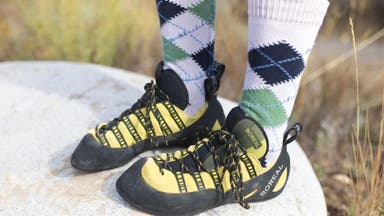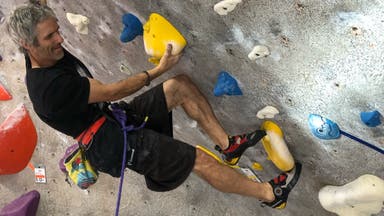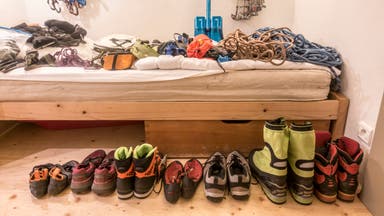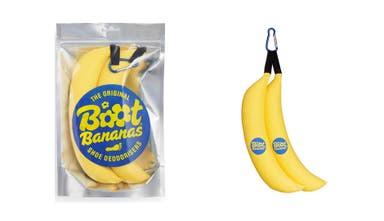If you buy through our links, we may earn an affiliate commission. This supports our mission to get more people active and outside.Learn about Outside Online's affiliate link policy
Your Partner Thinks Your Climbing Shoes Stink. Here Are 7 Ways to Fix That.
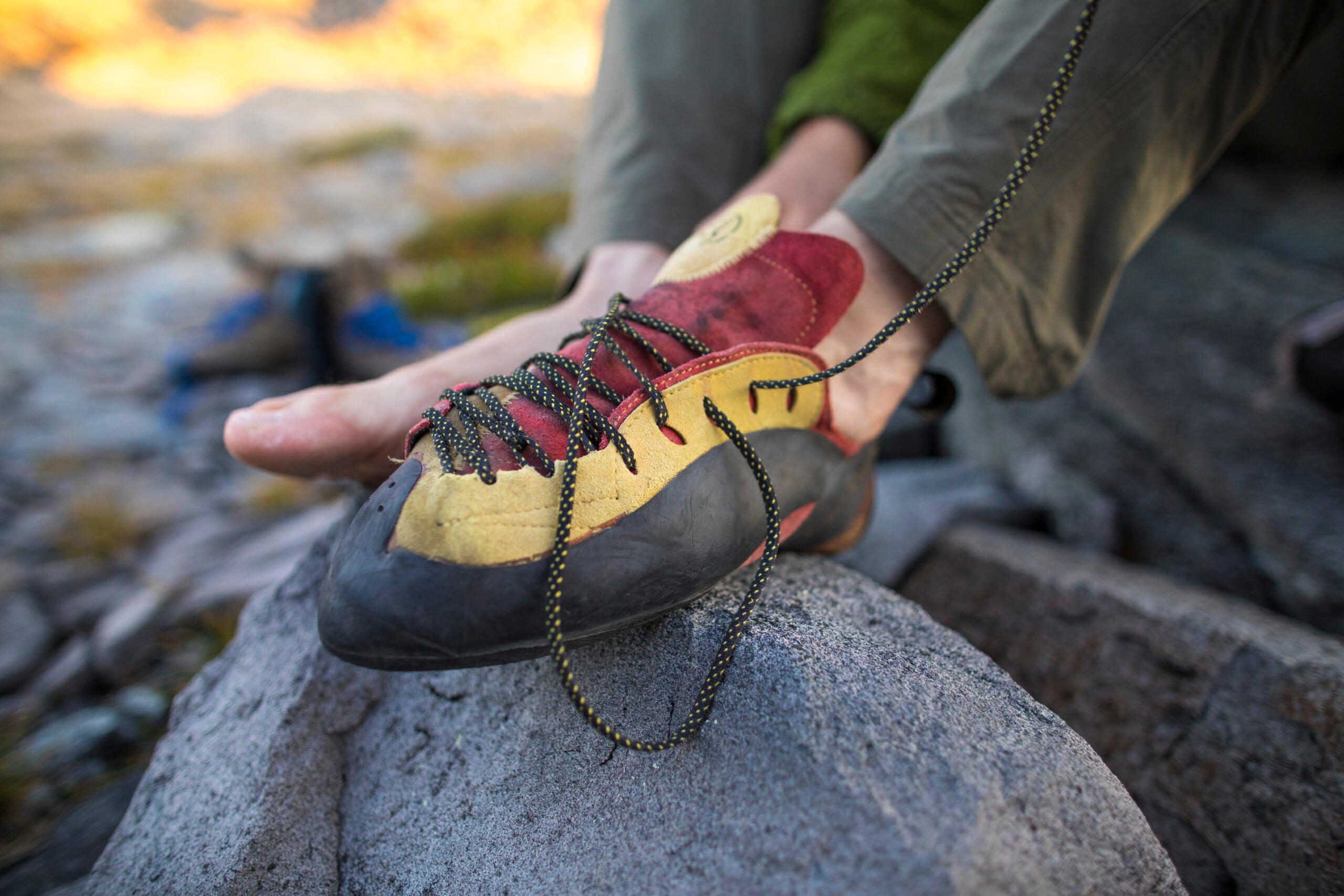
(Photo: Cavan Images / Getty)
Everyone knows that smelly climbing shoes are a surefire way to stink up your tent and scare away prospective climbing partners. Even the dirtiest dirtbags don’t want their feet to reek of the aged cheese Céüse climbers house between burns.
Unfortunately, stinky shoes are an all too common problem among climbers. A couple culprits? An intentionally tight fit and durable design that’s incompatible with breathability. It also doesn’t help that most climbers opt out of socks while climbing.
There are three stages when it comes to fighting foul odors in climbing shoes:
- Prevention: Don’t let your shoes get smelly in the first place.
- Removal: Get rid of odors already embedded in your shoes—for good.
- Cover-up: Mask the foulness when you’re in a pinch and don’t want to torment your belayer.
How to prevent stinky climbing shoes in the first place
Start climbing with clean, dry feet
Don’t set yourself up for failure by putting dirty, sweaty, or already smelly feet into climbing shoes. Before you start climbing, clean and dry your feet. If you can’t wash your feet before a climbing session, bring some wipes along in your pack. For a more sustainable option, try bringing a couple reusable wipes or cloths and dousing them with a bit of water and/or a couple drops of essential oils and give your feet a wipe down.
Our Picks
If you’re particularly prone to foot sweat and odors, this can also be an effective strategy on longer multi-pitch routes or big walls. Clean off your feet—and air them out—between pitches! One or two wipes adds minimal weight and bulk in a pack.
Let your shoes air out in between sessions
Storing your shoes in an enclosed pack or bag lets sweat, bacteria, and smells fester. The solution? Air your shoes out whenever you’re not climbing. As soon as you can, remove your shoes from your pack or bag and store them in a well-ventilated area. Hint: The trunk of your car or a small closet is not a well ventilated-area. If possible, hang them up to dry with a carabiner on a hook in a mud room, open gear closet, covered porch, or other airy spot.
Surrender your ego and wear socks
One of the reasons climbing shoes become so notoriously rank is that there’s no barrier between your sweaty foot and the shoe. While many climbers would rather give off heinous stenches than be caught wearing socks with climbing shoes, socks will help absorb sweat and prevent smells from developing. In fact, this nine-year-old, who recently became the youngest to send 5.14b (in socks), refuses to climb without socks. If you go this route, choose ultra-thin socks that won’t interfere with fit or performance for most climbers. Competitive, high-level, or dedicated slab climbers, however, might feel otherwise.
How to remove odors from your climbing shoes
Powder your shoes
When you air out those shoes, sprinkle some baking soda over the soles, shake them up, and let that sodium bicarbonate sit overnight—or until your next session. Baking soda is absorbent and can help neutralize those send-induced smells.
If baking soda isn’t cutting it, try On Your Toes foot powder, which promises to banish the funk for up to six months. Though if you’re really struggling with shoe odors, you might powder your shoes once a month, every few sessions, or when you notice the smell returning.
Put a banana in your shoes
Not an actual banana, but a boot banana. Co-designed by a climbing instructor, these moisture-absorbing shoe inserts soak up sweat and wipe out odors with a mix of minerals, salts, and essential oils. Also, like actual bananas, they turn brown when they’re reaching the end of their lifespan (this means it’s time to grab a new pair). Stick them in your climbing shoes after each session to soak up any unsavory smells.
Try vinegar
If powders and inserts have not quelled the smell, it’s time to introduce some acid to kill any pesky bacteria. Mix equal parts water and distilled white vinegar. Then use this solution to spray your shoes. Let it sit for a few hours before rinsing and air-drying. For a more aggressive intervention, scrub the shoes with this vinegar solution and a cleaning brush or microfiber cloth—or soak the shoes in a water-vinegar solution. While some have also resorted to hydrogen peroxide to banish bacteria, hydrogen peroxide can be corrosive, so it’s less than ideal, as it could damage your shoe’s materials.
How to mask stinky climbing shoes
Apply essential oils
Let’s say you accidentally left your shoes in your pack and are now about to go on a climbing date. Or you are heading to the crag in a couple hours and don’t have time for prevention or odor removal measures. If you need a quick cover-up for those stinky shoes, try spritzing some essential oils into the shoe. Lemon or lavender are always pleasant. Tea tree oil, while pungent, will likely be the most effective in obscuring stenches. You can mix essential oils with water and spray on your shoes, or buy a pre-diluted essential oil spray designed specifically for shoes, like this one.
What not to do to make your shoes smell better
There are some things you should never resort to when it comes to fighting the stink, no matter how bad those shoes reek. In your attempt to air out your shoes, never leave them out in the sun. While short spells under UV rays at the crag are fine, storing them under the sun or leaving them in sunny spots for extended periods can damage your shoes.
Another shoe taboo? Putting your shoes in the washing machine. Scarpa cautions that you should never put climbing shoes in the washing machine, because it can cause damage to shoe materials. Instead, wash your shoes by hand.
When all else fails …
Lastly, if after all of these measures your shoes still smell, consider recycling them instead of chucking them in the trash. You can recycle your shoes through the GotSneakers shoe recycling program, or order a Trashie Bag and throw your shoes in with any old clothes you no longer want.
And if you’re ready to start a clean slate when it comes to climbing shoes, check out some of our shoe picks and don’t forget to follow our odor prevention tips to keep them fresh.
